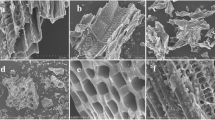Abstract
An activated carbon-impregnated cellulose filter was fabricated, and the capacity to remove dust and volatile organic compounds was evaluated in a laboratory. The adsorption capacities for benzene, toluene, ethyl benzene and m-xylene gases were compared by an adsorption isotherm test conducted as a preliminary test, showing that m-xylene and benzene were the most and least favorable for adsorption onto activated carbon, respectively. Cellulose filters were made with four levels of activated carbon contents, and dust removal was performed with all of the filters showing 99 % and higher efficiencies stable with a small variation during the experiment. Activated carbon content of 5 g in the unit filter area (125 g/m2) was found optimum for benzene, toluene, ethylbenzene and m-xylene removal, as it appeared that higher than 5 g activated carbon content was unnecessary for the improvement of its capacity. With increasing benzene, toluene, ethylbenzene and m-xylene loading, the highest removal rates were determined as 0.33–0.37 mg/cm2 s for as short as 0.0046 s of air filter residence time. The rapid removal was possible because of the high surface area of the activated carbon-impregnated cellulose filter provided by powdered activated carbon, which is distinguished from the granular form in conventional activated carbon towers. As fixed within a cellulose scaffolding structure, the powdered activated carbon performed excellent benzene, toluene, ethylbenzene, and m-xylene adsorption (98.9–100 %), and at the same time, particular matters were removed in average 99.7 % efficiency after being filtered through the cellulose filter sheet.








Similar content being viewed by others
References
Bastani A, Lee C-S, Haghighat F, Flaherty C, Lakdawala N (2010) Assessing the performance of air cleaning devices—a full-scale test method. Build Environ 45:143–149
Cal MP, Rood MJ, Larson SM (1996) Removal of VOCs from humidified gas streams using activated carbon cloth. Gas Sep Purif 10(2):117–121
Chiang Y-C, Ciang P-C, Huang C-P (2001) Effects of pore structure and temperature on VOC adsorption on activated carbon. Carbon 39:523–534
Das D, Gaur V, Nishith V (2004) Removal of volatile organic compound by activated carbon fiber. Carbon 42:2949–2962
Devine S, O’Reilly S, Stillo A, Thornburg D (2013) A science-based approach to selecting air filters. Pharm Eng 33(1):1–12
Foo KY, Hameed BH (2010) Insights into the modeling of adsorption isotherm systems. Chem Eng J 156:2–10
Gupta K, Rao N, Agarwal G (2012) Adsorption of xylene on granular activated carbon in a packed bed. Int J Sci Technol Res 1(3):90–93
Haghighat F, Lee C-S, Pant B, Bolourani G, Lakdawala N, Bastani A (2008) Evaluation of various activated carbons for air cleaning—towards design of immune and sustainable buildings. Atmos Environ 42:8176–8184
Hwang KS, Lee WK (1994) The adsorption and desorption breakthrough behavior of carbon monoxide and carbon dioxide on activated carbon. Effect of total pressure and pressure-dependent mass transfer coefficient. Sep Sci Technol 29(14):1857–1891
Jo W-K, Chun H-H (2014) Application of fibrous activated carbon filter in continuous-flow unit for removal of volatile organic compounds under simulated indoor conditions. Aerosol Air Qual Res 14:347–354
King B, Do DD (1996) Measurement of multicomponent adsorption kinetics of gases in activated carbon by a batch adsorber FT-IR technique. Chem Eng Sci 51(3):423–439
Lorimier C, Subrenat A, Le Coq L, Le Cloirec P (2005) Adsorption of toluene onto activated carbon fiber cloths and felts: application to indoor air treatment. Environ Tech 26(11):1217–1230
Ramirez D, Qi S, Rood M, Hay K (2005) Equilibrium and heat of adsorption for organic vapors and activated carbons. Environ Sci Technol 39:5864–5871
Ramos M, Bonelli P, Cukierman A, Carrott M, Carrott P (2010) Adsorption of volatile organic compounds onto activated carbon cloths derived from a novel regenerated cellulosic precursor. J Hazard Mater 177(1–3):175–182
Schroth T (1996) New HEPA/ULPA filters for clean-room technology. Filtr Sep 33(3):245–250
Sidheswaran MA, Destaillats H, Sullivan DP, Cohn S, Fisk W (2012) Energy efficient indoor VOC air cleaning with activated carbon fiber filters. Build Environ 47:368–372
State of California Air Resources Board (1986) Determination of high concentrations of benzene from stationary source. Method 410B
Vaughn E, Ramachandran G (2002) Fiberglass vs. synthetic air filtration media. Int Nonwoven J 11(3):41–53
Yaws CL (1995) Handbook of transport property data: viscosity, thermal conductivity, and diffusion coefficients of liquids and gases, Huston. Tex. Gulf Pub. Co., Huston
Yoon Y, Kim S, Ahn K, Ko K, Kim KS (2016) Fabrication and characterization of micro-porous cellulose filters for indoor air quality control. Environ Tech 37(6):703–712
Acknowledgments
This work was supported by a Korea Institute of Civil Engineering and Building Technology (KICT) internal project titled “Development of dust moving technology and cellulose filter/inorganic adsorbent impregnated with iron to remove indoor fine dust” under Grant Number 20160158-001-01.
Author information
Authors and Affiliations
Corresponding author
Rights and permissions
About this article
Cite this article
Kim, S.Y., Yoon, Y.H. & Kim, K.S. Performance of activated carbon-impregnated cellulose filters for indoor VOCs and dust control. Int. J. Environ. Sci. Technol. 13, 2189–2198 (2016). https://doi.org/10.1007/s13762-016-1046-8
Received:
Revised:
Accepted:
Published:
Issue Date:
DOI: https://doi.org/10.1007/s13762-016-1046-8




